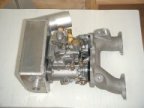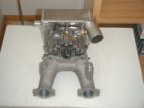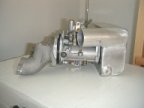


Ever since Vizardīs book about A-series engine tuning was published I have admired the Janspeed turbo setup and especially the Dellorto carb. I even contacted Janspeed to get additional info but never got any answers. Also, when I tried to track down any metros with this setup I did not find any. Eventually I have gotten bored with the SU HIF44 with eternal needle modifications and trying to perfect the setup. This is even more difficult with tall diff where the engine needs to pull from very low. It is 95 % but still not perfect.
So, I have kept my eyes open in case a suitable Dellorto DHLA 45M showed up. I am not sure but assume that the carb used on Janspeed setup is Dellorto 40. Dellorto 45M was specially made for blowthrough turbo setup and includes sealed throttle shafts, rubber gaskets and a special power jet circuit to feed more fuel at top end. With blow-through it is possible to lean out at high revs so this circuit enables to feed additional fuel based on air flow at carb mouth. New ones are no longer available and second hand units very difficult to find. Eventually I found a pair that had seen very little use. One kept, another sold to a friend.
I also bought a new Janspeed manifold which is also mentioned in Vizardīs book and should be pretty good flowing unit. It is pretty compact and fits very nice in my engine room.
I fabricated a special plenum chamber for the carb from 4 mm aluminium sheet and TIG-welded it together. Plenum chamberīs volume is about 1,6 litres, based on the recommendation 1,1-1,2 times the engine displacement. (A book called "Maximum boost" by Corky Bell) I could have chosen a thinner plate but this will not collapse... I also turned a set of stub stacks on a lathe. The stub stacks fit in the chamber at the carb inlets and should direct the flow better. The stub stacks are fitted with countersunk head screws and provide studs to fasten to the carb inlet flange.
The completed plenum chamber:
The initial idea was to fit the carb and manifold and use the existing turbo. But the intake manifold would not fit with turbo manifold. So the carb was put back into storage and planning proceeded. I bought another smaller turbo and chose to fabricate a new manifold for the new turbo. The design of the manifold would allow enough clearance for Janspeed intake manifold.
Still the idea of comparing the carbs was interesting. So another exhaust manifold was borrowed and the Janspeed intake manifold ground for clearance. A couple of holes appeared in intake runners but I had enough clearance to fit the Janspeed manifold to std exhaust manifold. Small patches were fabricated of aluminium sheet and welded to the manifold.
So, the engine was fitted with Dellorto and Metro turbo T3. After the engine is set up I will have it on rollers for comparison. I expect to gain more drivability by easier setting with fixed jets and possibly more power at higher revs with better flowing induction system.
The intercooler pipes had to be slightly modified to match the new carb setup. The turbo intake and air filter were also relocated outside of the engine room, just below the LH head light, under the front wing. Previously the air filter was located next to the intercooler where the ambient air temp is higher. This was a compromise because there was not enough space elsewhere. The new location should provide cold air.
Here are a couple of pics showing the new carb setup fitted in the car.
I took the engine to rolling road to get a base line power curve prior to changing the turbo and carb, see the rolling road report before the modifications.
I had to fabricate a bulkhead box to gain some room for the carb and plenum, typical for any Mini having a Weber or Dellorto carb. I finally got everything fixed and it was time for the first start with a new carb. But, no fuel. Eventually this was traced to bent float which kept the float needle shut. After this was fixed the engine ran. Jetting was first a nightmare. The setup that the carb had was nowhere near anything reasonable. Engine ran OK at low revs but would not rev past 3000 rpm. Which was expected...
During the following weeks I tried various settings, trying to make one change at a time to figure out whether it was for better or for worse. Initial spec was as follows:
| Initial setup: | |
|---|---|
| Choke: | 36 mm |
| Auxiliary venturi: | .2 |
| Idle jet + holder: | 60 / 1 |
| Main jet: | 170 |
| Air corrector: | 180 |
| Emulsion tube: | 6 |
| Pump jet: | 40 |
Two major problems were present during the setting: hesitation just off idle and severe hesitation during transition to main jet. I tried to fix the off idle hesitation with larger pump jets but even a 70 jet would not fix it completely. Eventually the problems was found in the linkage. There was a small gap between the linkage and the piston of the pump diaphragm. When accelerating there was a short delay before the pump jets squirted fuel, causing hesitation.
The hesitation during transition was present no matter which emulsion tube. I tried 6, 5, 7, 13 and 14 with bigger and bigger jets but could not fix it completely. Of these, 13 was the closest match and eventually I managed to get the engine running somehow with 190 main and 170 air corrector. Ridiculous setting so something needed to be done. I visited the local dealer and they suggested fitting smaller choke and another auxiliary venturi. So I removed the carb, bought 34 mm chokes and .1 aux. venturis and fitted them. Instantly the engine felt more tractable. Smaller chokes equal to higher air speed and stronger signal to aux. venturi. The difference with .2 and .1 aux. venturis is a pair of cuts machined in the tail of the .2 venturi. This is to reduce the signal during transition where blow thru turbos tend to run rich. Not in my case... Stronger signal in the aux. venturi makes the carb to come sooner to main jet and the emulsion tube selection and jetting should be easier.
| Revised setup: | |
|---|---|
| Choke: | 34 mm |
| Auxiliary venturi: | .1 |
| Idle jet + holder: | 60 / 1 |
| Main jet: | 170 |
| Air corrector: | 180 |
| Emulsion tube: | 13 |
| Pump jet: | 60 |
June 9, 2001
More road testing with major fuel consumption made me think about the emulsion tube choice. Emulsion tube 13 currently fitted worked pretty nice apart from hard acceleration where the mixture leaned out badly. This is characteristic to 13 emulsion tube which I could not fix with any main jet/air bleed combination. So I simply fitted emulsion tube 6 to see if it would make any difference. To my surprise this worked OK with smaller 34 mm chokes. With 36 mm chokes this emulsion tube did not work at all. So, jetting began again with fresh ideas. Now the engine feels better during acceleration. An odd feature is that I need to use a lot larger pump jets than recommended in any reference source. This seems to be typical to other local cars as well.
| Revised setup #2: | |
|---|---|
| Choke: | 34 mm |
| Auxiliary venturi: | .1 |
| Idle jet + holder: | 58 / 1 |
| Main jet: | 180 |
| Air corrector: | 160 |
| Emulsion tube: | modified 6 |
| Pump jet: | 70 |
August 6, 2001
Jetting update: I am yet to find a perfect emulsion tube. There are tubes that work perfect at mid range but lean at high revs. And vice versa. I modified an emulsion tube 6 and did get it work better. I had a chat with a local rolling road tuner who has a long experience with turbo cars and he commented about the choke sizes. I thought that 34 mm chokes are still too large for the engine. So I went and fitted 32 mm chokes to see if it makes things any easier.
| Revised setup #3: | |
|---|---|
| Choke: | 32 mm |
| Auxiliary venturi: | .1 |
| Idle jet + holder: | 55 / 1 |
| Main jet: | 170 |
| Air corrector: | 160 |
| Emulsion tube: | modified 2 |
| Pump jet: | 60 |
August 8, 2001
I managed to book a session at a local rolling road where the operator has a long experience with turbocharged cars. First run showed that transition was too rich and top end leaned out totally. After checking the fuel pressure and pump the needle valve was suspected to be a touch small. I reamed it larger and it helped some. Next we replaced the emulsion tubes with 6īs. This made the top end richer. Still the transition was too rich at full load. We suspected taht the aux. venturies were too sensitive and the operator recommended that current .1īs be replaced with .2īs. Further findings: despite the choke size the engine needs big main jets. I replaced the aux. venturis with the original .2īs.
| Revised setup #4: | |
|---|---|
| Choke: | 32 mm |
| Auxiliary venturi: | .2 |
| Idle jet + holder: | 56 / 1 |
| Main jet: | 180 |
| Air corrector: | 150 |
| Emulsion tube: | 6 |
| Pump jet: | 60 |
August 13, 2001
With the .2 aux. venturis feels better. I changed the main jets to 190 with made the engine better. Still there is a hesitation at about 2500 rpm but it is a bit hard to tell whether the mixture is too rich or lean. A new session on the rolling road should fix that. Now the engine feels like it should be. I also experimented with higher boost and the mixture seems to be pretty good even with higher boost.
September 10, 2001
A tip from Dan Ruble in San Jose: Turbomania book (by Bob Tomlinson) that covers all kind of VW turbo setups. VWs run "modulator rings" with blow thru carbs. These modulator rings are simple restrictions at the carb mouth. The jetting specs for VW engines suggested that the restrictions should be sized the same as the carb chokes (venturis). So I cut my plenum apart, removed the stub stacks and turned a couple of inserts with 34 mm ID diameter. Interesting to see how much I need to change my jetting. Incidentally, MG turbos have a similar arrangement: there is an odd looking brass tube inside the plenum.
1.11.2001Driving season is just about over, cold mornings at high 30īs give some visibility problems. Jetting is pretty close as the engine fires easily without the choke once the correct technique was found. 34 mm chokes and modulator rings worked pretty nice, in fact better than 32 mm chokes alone. 15 psi boost settings are a bit too much for the chassis since the car pulls all over the place at full throttle. I did yet another experiment and replace the chokes to 32 mm ones. This made the drivability much better. In comparison, 34 mm chokes were a bit sensitive at times with small throttle openings. Now the mixture is rich across the range and even at full throttle. I tried 170 main jet but still the mixture is rich. It seems that I will have to try another exmulsion tube that is a slightly leaner at low revs.
| Last set of jetting with T03 charger | |
|---|---|
| Choke: | 32 mm+34 mm modulator rings |
| Auxiliary venturi: | .2 |
| Idle jet + holder: | 55 / 1 |
| Main jet: | 180 |
| Air corrector: | 140 |
| Emulsion tube: | 6 |
| Pump jet: | 60 |
Summer 2002
Summer 2002 showed no real revelations with the jetting. Rich at cruising, partially lean at full load. Lots of testing with modified tubes but no success. Load of e-mailing with Diniz Gomes from Portugal gave some new ideas about the emulsion tubes and this initiated some new modifications to test in the spring.
May 2003
A short update on Dellorto jetting: I took the car to my mateīs private rollers to get an idea what is really happening. The major problem has so far been fuel consumption and lean mixture at some throttle openings and heavy acceleration. I simply could not find any emulsion tube that could have corrected the problem. I even did some of my own tubes but they did not help either.
So, with 2 summerīs jetting experience I took the car to my mateīs and he did some runs on the rollers. Baseline jetting was as follows:
| First setup on rollers | |
|---|---|
| Choke: | 36 mm+36 mm modulator rings |
| Auxiliary venturi: | .2 |
| Idle jet + holder: | 55 / 9 |
| Main jet: | 170 |
| Air corrector: | 200 |
| Emulsion tube: | modified 14 |
| Pump jet: | 60 |
First run with light load confirmed the fact that at very light loads the mixture was ultra rich. At full load the lambda signal went off the scale. Since the engine also produced a lot of smoke I figured that it was too rich. I chose to fit .6 emulsion tubes to provide a solid baseline for jetting. These are common for tuned n/a Minis and the engine ran reasonably well with them. A first run with .6 tubes and above jetting gave similar results: initially rich and at about 2500 rpm the lambda went off the scale. To check what caused the lambda to show blank display we replaced the 170 main jets with 190 main jets and made another run. To our big surprise the mixture had been ultra lean and it was partially corrected. And I had been thrashing the car with 1 bar boost Shit, whoever says that 1380 engines do not last with turbos donīt know anything !!!
Next step was to fit smaller air jets to provide more fuel at higher revs. Out with the 200 airs, in the 150 air jets. Now the mixture held pretty nice but was still a somewhat lean for serious power. So, I put 120 air jets in and did another run. Now the mixture stayed rich all the way and the engine liked it.
At 0,7 bar the jetting looked like this:
| Second setup on rollers | |
|---|---|
| Choke: | 36 mm+36 mm modulator rings |
| Auxiliary venturi: | .2 |
| Idle jet + holder: | 55 / 9 |
| Main jet: | 190 |
| Air corrector: | 120 |
| Emulsion tube: | 6 |
| Pump jet: | 60 |
Not exactly a typical jetting with 36 mm chokes but pretty much spot on. The engine was still rich during transition from idle jets to main jets. Last run was made with solenoid on and boost at 1 bar. Now the mixture was leaning again but I did not have any bigger main jets. Judging by the lambda curve the mains need to be 200-210 for correct mixture.
I replaced the 55 idle jets with 52 jets and now the engine runs nice when going at a steady 100 km/h. Previously the engine ran ultra rich but now it seems to be better. There is still some fine tuning to find a proper jet size, maybe a 53 or 54 will do the trick. The biggest surprise perhaps was the difference between the idle jets. The increasing fuel pressure makes the choice of idle jets difficult, it seems that the idle circuit supplies fuel a lot longer than in n/a setup. Anyway, now it is pretty much spot on.
| Back to Mini Turbo - Homepage | Mini Turbo - Engine assembly | Mini Turbo - Problems | Mini Turbo - Rolling road reports | Mini Turbo - Body modifications |
|---|---|---|---|---|
| Back to Jukkaīs HomePage | ||||
| Updated May 21, 2003. | ||||